Abstract
Biochemical changes which occur in a smooth strain of Escherichia coli were investigated with hyperimmune rabbit serum as a source of antibody and fresh normal guinea pig serum as a source of complement. Ribonucleic acid synthesis, as shown by incorporation of 3H-uridine, was decreased as early as 5 min, and deoxyribonucleic acid synthesis, shown by incorporation of 3H-thymidine, was decreased after 15 min of reaction. Incorporation of glycerol-2-3H into membrane lipid ceased after 25 to 30 min, probably as a result of functional or physical disruption of the membrane, or both. Permeability control (as indicated by loss of 3H-uridine-labeled compounds and by decrease in optical density) and protein synthesis were subsequently shown to be affected after 30 min. The metabolic state of the bacteria was found to be important in determining the outcome of the reaction. This was shown by the influence of the type of medium on the reaction. A complex nutrient medium decreased susceptibility as compared with a simple medium. The energy sources glycerol and acetate also decreased susceptibility. It is postulated that the ability of the cell to prevent or repair damage to the cell membrane may be involved. Therefore, metabolic conditions which allow retention of vital processes associated with the cytoplasmic membrane and cell surface will mitigate the bactericidal effect. Such conditions may occur in vivo during bactericidal reactions.
Full text
PDF
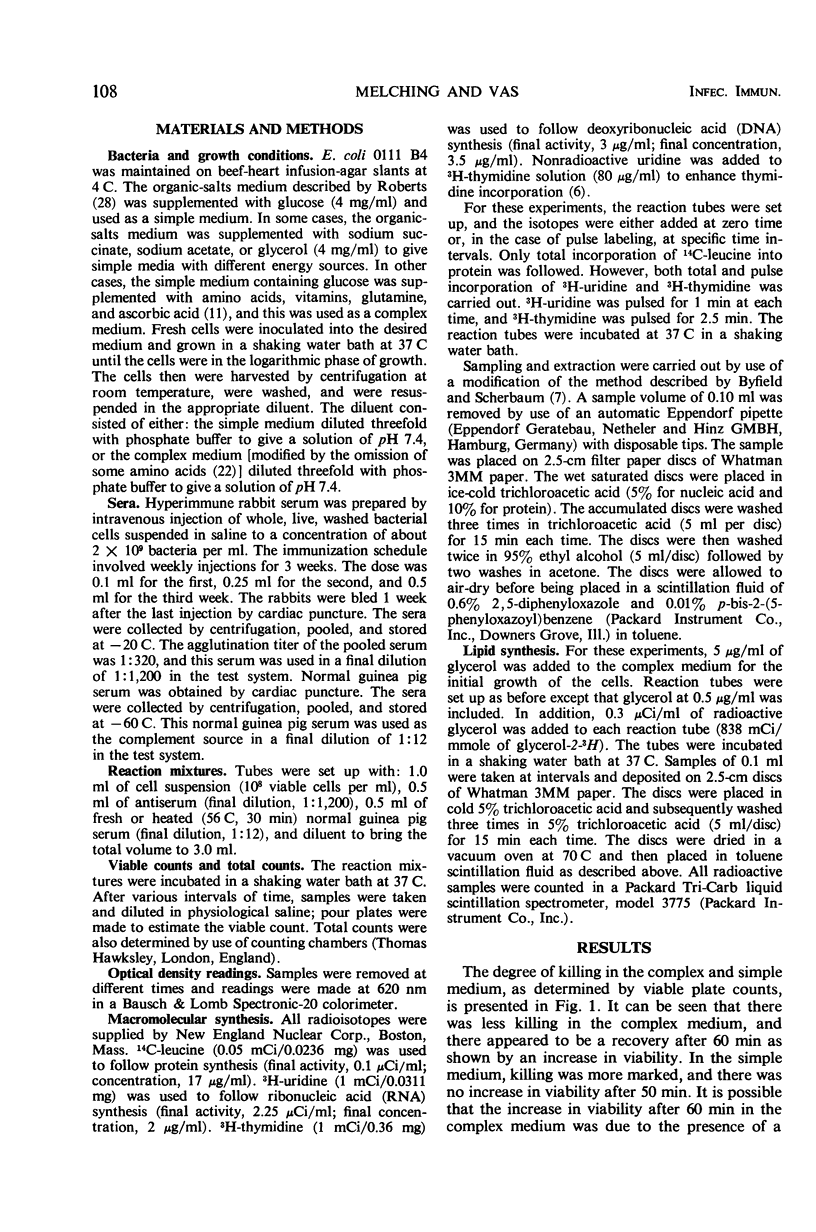
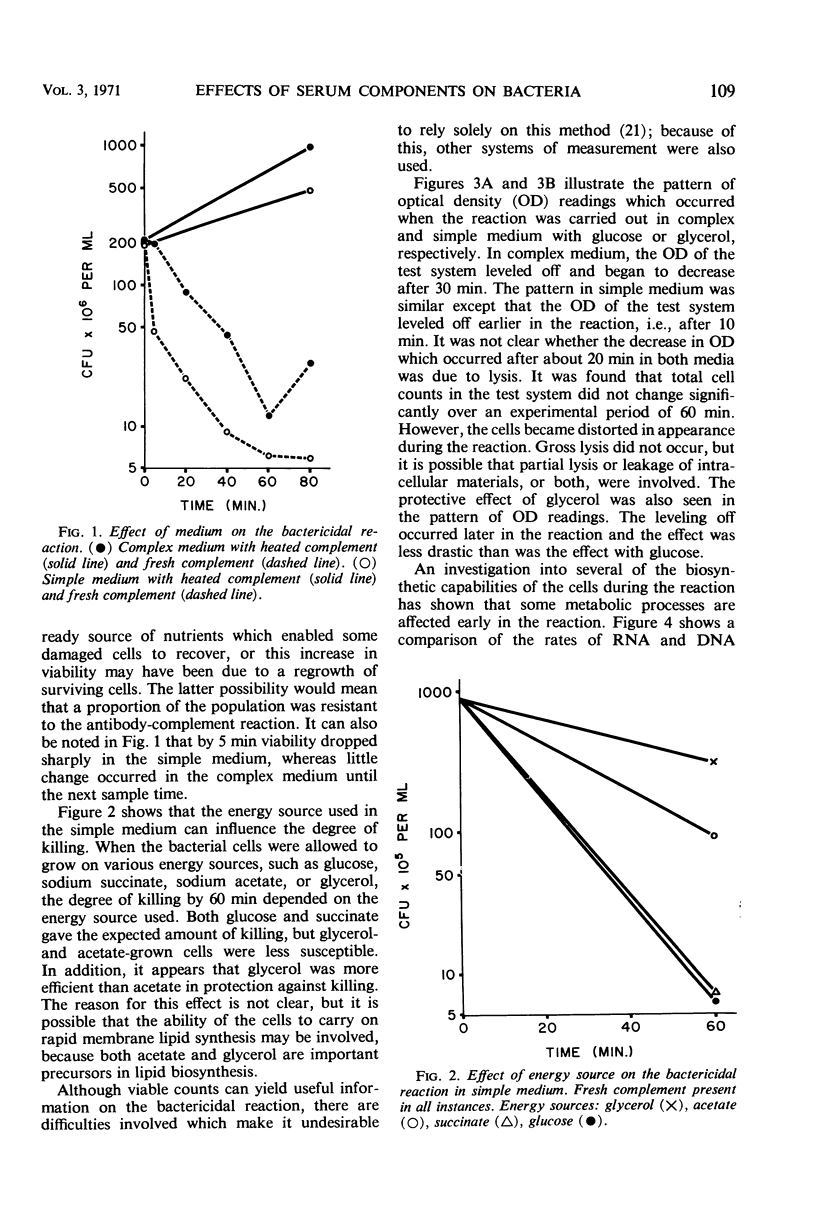
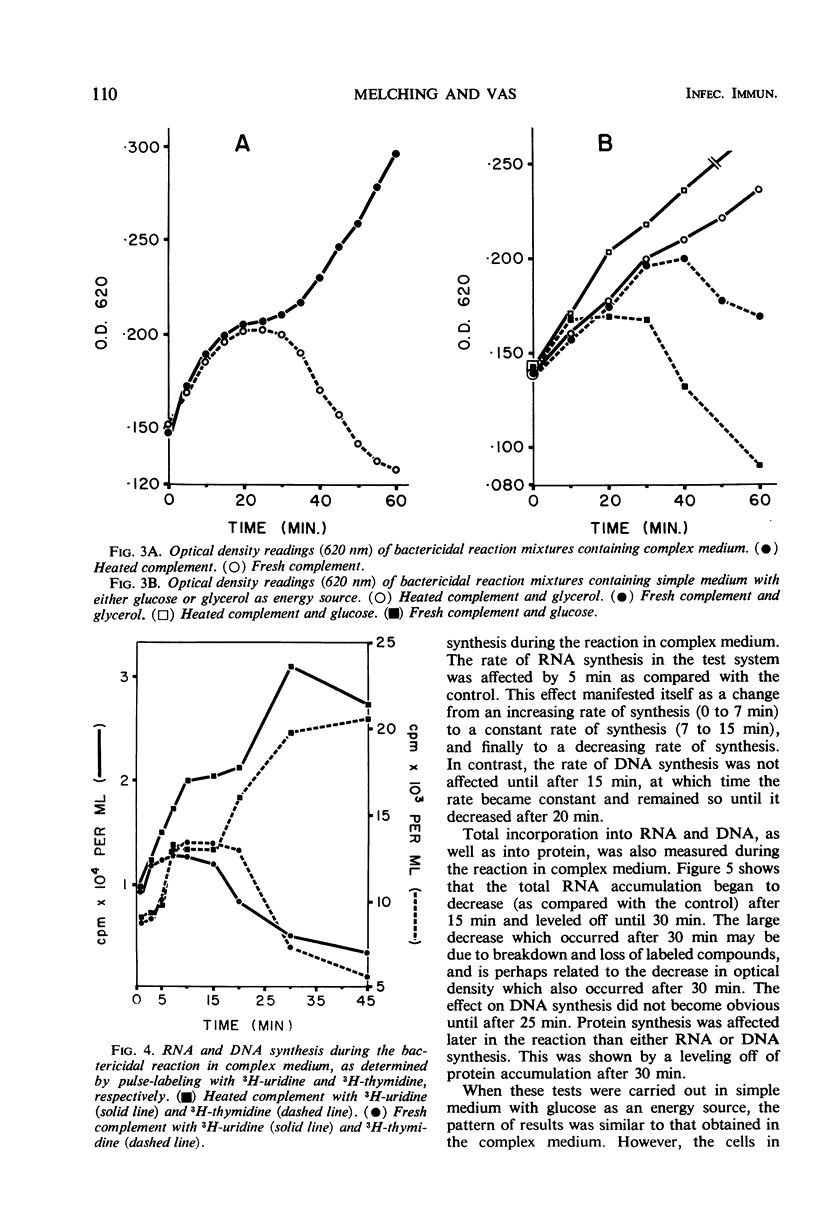

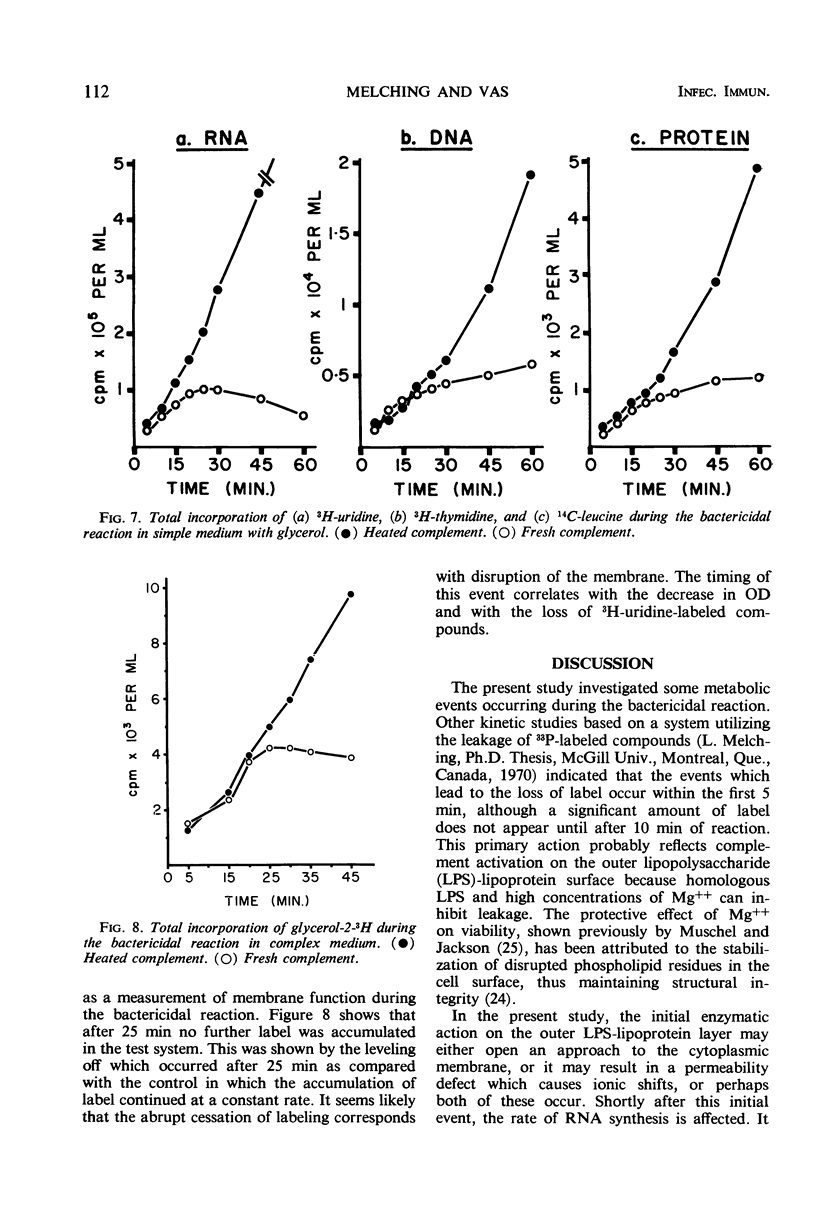

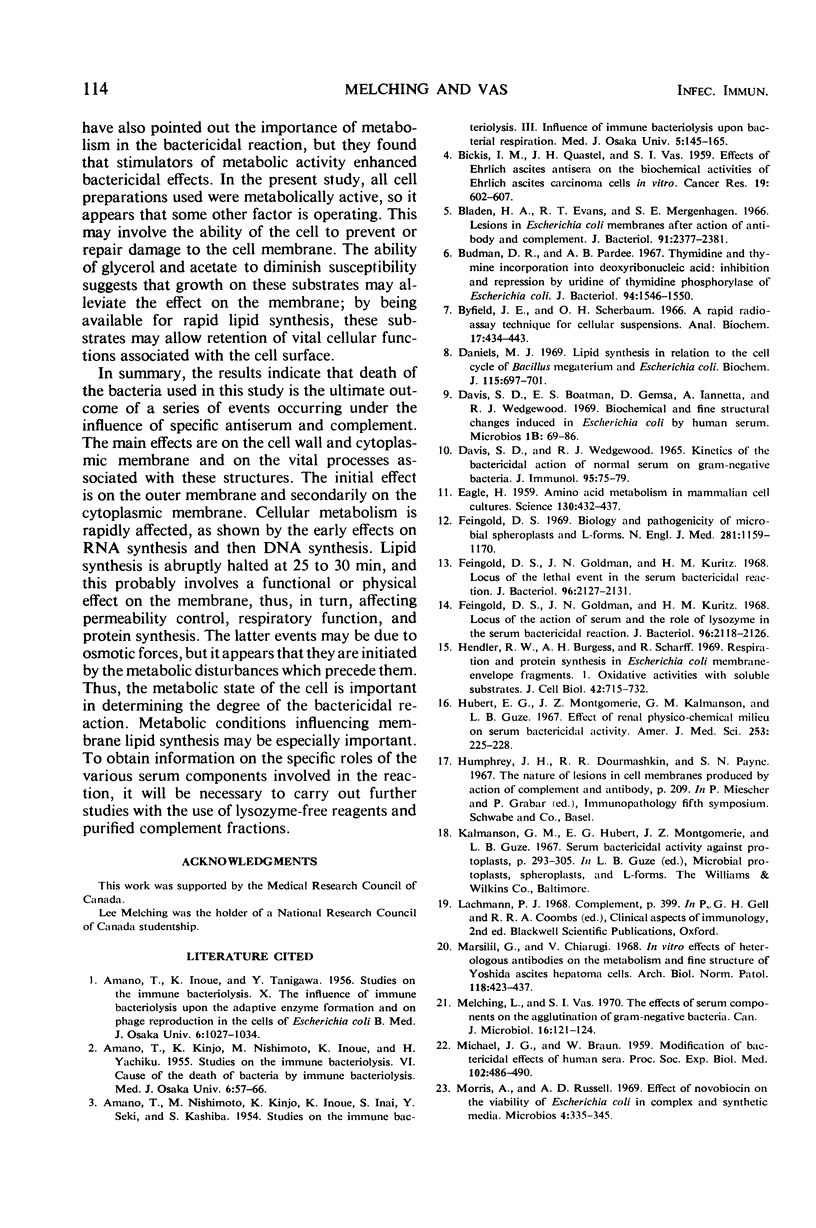

Selected References
These references are in PubMed. This may not be the complete list of references from this article.
- BICKIS I. J., QUASTEL J. H., VAS S. I. Effects of Ehrlich ascites antisera on the biochemical activities of Ehrlich ascites carcinoma cells in vitro. Cancer Res. 1959 Jul;19(6 Pt 1):602–607. [PubMed] [Google Scholar]
- Bladen H. A., Evans R. T., Mergenhagen S. E. Lesions in Escherichia coli membranes after action of antibody and complement. J Bacteriol. 1966 Jun;91(6):2377–2381. doi: 10.1128/jb.91.6.2377-2381.1966. [DOI] [PMC free article] [PubMed] [Google Scholar]
- Budman D. R., Pardee A. B. Thymidine and thymine incorporation into deoxyribonucleic acid: inhibition and repression by uridine of thymidine phosphorylase of Escherichia coli. J Bacteriol. 1967 Nov;94(5):1546–1550. doi: 10.1128/jb.94.5.1546-1550.1967. [DOI] [PMC free article] [PubMed] [Google Scholar]
- Byfield J. E., Scherbaum O. H. A rapid radioassay technique for cellular suspensions. Anal Biochem. 1966 Dec;17(3):434–443. doi: 10.1016/0003-2697(66)90179-5. [DOI] [PubMed] [Google Scholar]
- DAVIS S. D., WEDGWOOD R. J. KINETICS OF THE BACTERICIDAL ACTION OF NORMAL SERUM ON GRAM-NEGATIVE BACTERIA. J Immunol. 1965 Jul;95:75–79. [PubMed] [Google Scholar]
- Daniels M. J. Lipid synthesis in relation to the cell cycle of Bacillus megaterium KM and Escherichia coli. Biochem J. 1969 Dec;115(4):697–701. doi: 10.1042/bj1150697. [DOI] [PMC free article] [PubMed] [Google Scholar]
- EAGLE H. Amino acid metabolism in mammalian cell cultures. Science. 1959 Aug 21;130(3373):432–437. doi: 10.1126/science.130.3373.432. [DOI] [PubMed] [Google Scholar]
- Feingold D. S. Biology and pathogenicity of microbial spheroplasts and l-forms. N Engl J Med. 1969 Nov 20;281(21):1159–1170. doi: 10.1056/NEJM196911202812106. [DOI] [PubMed] [Google Scholar]
- Feingold D. S., Goldman J. N., Kuritz H. M. Locus of the action of serum and the role of lysozyme in the serum bactericidal reaction. J Bacteriol. 1968 Dec;96(6):2118–2126. doi: 10.1128/jb.96.6.2118-2126.1968. [DOI] [PMC free article] [PubMed] [Google Scholar]
- Feingold D. S., Goldman J. N., Kuritz H. M. Locus of the lethal event in the serum bactericidal reaction. J Bacteriol. 1968 Dec;96(6):2127–2131. doi: 10.1128/jb.96.6.2127-2131.1968. [DOI] [PMC free article] [PubMed] [Google Scholar]
- Hendler R. W., Burgess A. H., Scharff R. Respiration and protein synthesis in Escherichia coli membrane-envelope fragments. I. Oxidative activities with soluble substrates. J Cell Biol. 1969 Sep;42(3):715–732. doi: 10.1083/jcb.42.3.715. [DOI] [PMC free article] [PubMed] [Google Scholar]
- Hubert E. G., Montgomerie J. Z., Kalmanson G. M., Guze L. B. Effect of renal physico-chemical milieu on serum bactericidal activity. Am J Med Sci. 1967 Feb;253(2):225–229. doi: 10.1097/00000441-196702000-00010. [DOI] [PubMed] [Google Scholar]
- Marsilii G., Chiarugi V. In vitro effects of heterologous antibodies on the metabolism and fine structure of Yoshida ascites hepatoma cells. Sperimentale. 1968 Nov-Dec;118(6):423–437. [PubMed] [Google Scholar]
- Melching L., Vas S. I. The effects of serum components on the agglutination of Gram-negative bacteria. Can J Microbiol. 1970 Feb;16(2):121–124. doi: 10.1139/m70-020. [DOI] [PubMed] [Google Scholar]
- Muschel L. H., Jackson J. E. Reversal of the bactericidal reaction of serum by magnesium ion. J Bacteriol. 1966 Apr;91(4):1399–1402. doi: 10.1128/jb.91.4.1399-1402.1966. [DOI] [PMC free article] [PubMed] [Google Scholar]
- Muschel L. H., Larsen L. J. Effect of hypertonic sucrose upon the immune bactericidal reaction. Infect Immun. 1970 Jan;1(1):51–55. doi: 10.1128/iai.1.1.51-55.1970. [DOI] [PMC free article] [PubMed] [Google Scholar]
- ROTHER K., ROTHER U., PETERSEN K. F., GEMSA D., MITZE F. IMMUNE BACTERICIDAL ACTIVITY OF COMPLEMENT. SEPARATION AND DESCRIPTION OF INTERMEDIATE STEPS. J Immunol. 1964 Aug;93:319–330. [PubMed] [Google Scholar]
- Reynolds B. L., Rowley D. Sensitization of complement resistant bacterial strains. Nature. 1969 Mar 29;221(5187):1259–1261. doi: 10.1038/2211259a0. [DOI] [PubMed] [Google Scholar]
- SCHAECHTER M. Patterns of cellular control during unbalanced growth. Cold Spring Harb Symp Quant Biol. 1961;26:53–62. doi: 10.1101/sqb.1961.026.01.011. [DOI] [PubMed] [Google Scholar]
- Spitznagel J. K. Normal serum cytotoxicity for P32-labeled smooth Enterobacteriaceae. II. Fate of macromolecular and lipid phosphorus of damaged cells. J Bacteriol. 1966 Jan;91(1):148–152. doi: 10.1128/jb.91.1.148-152.1966. [DOI] [PMC free article] [PubMed] [Google Scholar]
- Spitznagel J. K., Wilson L. A. Normal serum cytotoxicity for P32-labeled smooth Enterobacteriaceae. I. Loss of label, death, and ultrastructural damage. J Bacteriol. 1966 Jan;91(1):393–400. doi: 10.1128/jb.91.1.393-400.1966. [DOI] [PMC free article] [PubMed] [Google Scholar]
- Wilson L. A., Spitznagel J. K. Molecular and structural damage to Escherichia coli produced by antibody, complement, and lysozyme systems. J Bacteriol. 1968 Oct;96(4):1339–1348. doi: 10.1128/jb.96.4.1339-1348.1968. [DOI] [PMC free article] [PubMed] [Google Scholar]


